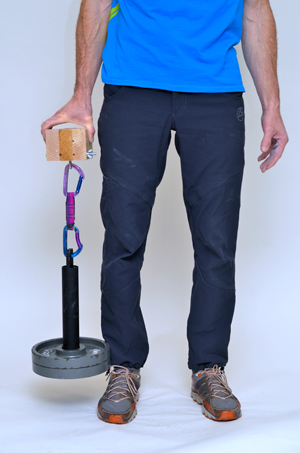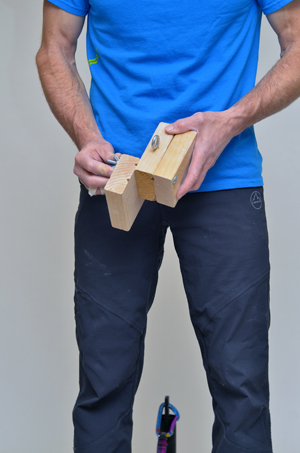Training the Wrist Stabilizers
The musculature of the forearms is some of the most complex in the body. For example, at first blush it seems that the forearm flexor muscles are almost single-handedly responsible for securing a tight grip to the rock. Consequently, exercises that target the forearm flexor muscles—such as the fingerboard, HIT System, campus board, or others—are the focus of most climbers’ training programs. The problem is that developing strong fingers and forearms that are also resistant to injury demands that you also regularly train the muscles that extend the fingers and wrist. Here’s why.
The finger flexors suffer from a sort of functional insufficiency in that they are much weaker when the wrist is flexed and the muscles are short. As an experiment, flex your wrist as much as possible (wrist angle around 90 degrees) and pinch your middle finger as hard as possible against the thumb. It’s hard to create much force, right? Now, while still pressing your middle finger against the thumb, slowly extend your wrist to a straight position and then an over-extended position. What did you notice? If you tried to squeeze hard throughout this range of motion you will have discovered that your finger strength increases as the wrist extends.
Biomechanically, there are a couple of reasons that finger strength is greater with an extended wrist position. First, muscles can contract more forcefully when they are elongated, as the finger flexors are with an extended wrist position. More interesting, however, is how the fingers naturally assume a hook-like position when the wrist is over-extend. Try it right now—over-extend your wrist and you’ll see the meat-hooks revealed!
Now, you know why fatiguing climbers lift their elbows into the chicken-wing position—it puts their wrist a position that enables pumped forearms to grip a little longer. Done chronically, however, such chicken winging stresses the extensor muscles and puts added stress on the tendon pulleys in the fingers. The result can be gradual onset of lateral epicondylitis and/or finger tendon problems.
The training “fix”, then, is to dedicate a modest amount of time to training the finger/wrist extensor muscles. No, you can’t just extend your fingers against a rubber band and called it “done.” You need to do some serious training in multiple ways, just as you train the finger flexors in a comprehensive manner! It’s paramount to train the wrist in both a neutral and extended position, as well as in a wide-pinch grip position—this is the single most-overlooked and important position to train it. While you don’t need to do all of the exercises every workout, at the minimum I suggest doing Reverse Wrist Curls, Wide Pinches, and Pronator Isolation. Do one set of these three exercises (with a light resistance) as part of your warm up for climbing (or training), and then do two more sets with higher resistance towards the end of your workout.

The Wide Block Pinch strengthens the wrist extensors with the fingers extended. Important!

Easy-to-make pinch blocks…made with three pieces of 2×4, a carriage bolt and wing nut, and lag screw eye bolt.
Wide Block Pinch
This novel exercise is absolutely essential as it strengthens the extensor muscles with the fingers fully extended as in grabbing open-hand and wide pinch holds in climbing. It may seem like a small distinction, but the wrist extensors function a bit differently when the fingers are straight (extended) compared with when the fingers are flexed, as in crimping or holding a dumbbell. So it’s important to do this exercise in addition to one of the previous.
Until there’s a commercially available device for training the wide-pinch grip, you’ll need to kludge something that will work. Screwing together two or three pieces of 2×4 wood blocks is a cheap, effective solution—consider making two sizes, wide and extra-wide. Another option is pinching a thick bumper weight plate. Anyway, the exercise is straightforward: standing upright with good posture, pinch the wood block or bumper plate with a straight arm and extended wrist; hold this position for ten to thirty seconds.
Initially, I suggest training for endurance, which will require a light weight that allows a full thirty-second hold. Do three with each hand with at least a minute rest in between. Longer-term, consider using a heavier weight that allows only a ten-second hold. In this case, do three consecutive ten-second pinches with the same hand, resting only thirty seconds between each. Do a total of three sets of three reps with each hand, resting about three minutes between sets.

